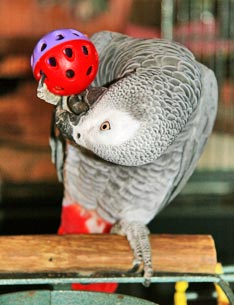
Parrots are very intelligent, playful, and curious creatures. They need plenty of stimulation to be happy. This includes time out of the cage, when they can fly around the room, and at least three hours of “socialization” with their “new flock” (that means you).
During the times when you’re away, or need to lock the parrot so you can finish household chores, be sure to leave at least 2 or 3 toys in the cage. These toys need to be rotated once every week. Parrots will easily tire of something they’ve seen everyday.
You may sometimes see a parrot panicking when it sees an unfamiliar toy. If that happens, lower the toy (so it looks smaller, and less overwhelming) and put it farther away, even just outside the cage. You can move it closer over the next few days, and pretty soon your parrot will realize that it’s nothing to be afraid of.
Parrots Toys-Toy Safety
Some cheap parrot toys are unsafe for the bird to use. It may have fragile parts that can be bitten off, becoming a possible choking hazard. It may also have sharp edges, or long strings that can entangle the bird’s legs or wings. Avoid cowbell or jingle bells that have small slits that can trap a claw or break.
To see how safe a toy will be, first introduce it outside of the bird’s cage to see how it will play with it. Only then can you be able to leave it in the cage without fear.
You should also look at how the toy will be attached to the cage. Don’t get any toys that have long chains or cords; they can easily get entangled, or choked, while you are aware. Dog clip or split ring attachments, on the other hand, can easily trap a parrot’s beak.
The safest ones are called “chooks” and are made of two U-shaped pieces that are joined with a screw. You can buy chooks separately to replace less sturdy attachments.
The size of the toy should also be appropriate for the size of your bird. Something “safe” for a small cockatiel may be a choking hazard for the macaw. The best thing to do is to ask the store owner if the toy is meant for a small, medium or large bird.
Parrots Toys-Materials
Wooden toys are good for chewing. Make sure that the wood is untreated, or that its dyes don’t contain lead or any toxic substances. Acrylic toys are generally safe. Other bird-sage materials are vegetable-tanned leather, 100% cotton, or sisal.